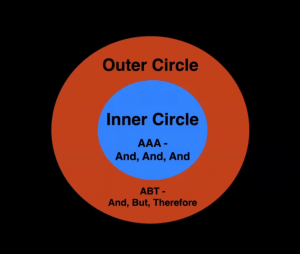ABT Framework Student Resource Page
Rounds 17
Contents
Sign up to host your Working Circle here (separate page)
Sign up to participate in Working Circles (separate page)
Download previous chat logs (separate page)
Session 2 Resources – Outer Circle / Singular Narrative
Session 3 Resources – Hero’s Journey
Session 4 Resources – Archplot
Session 5 Resources – The Fool with Patty Limerick
Session 6 Resources – Listening with Brian Palermo
Session 7 Resources – Audience as Hero with Park Howell
Session 8 Resources – Proposals with Dianna Padilla
Session 9 Resources – Narrative is Leadership
Session 10 Resources – Narrative Spiral with Nancy Knowlton
The ABT Framework Google Group
Social Media – Keep up with us on the web
Synopsis on Working Circles – If you’re new to Working Circles, start by reading this.
Working Circle Half Hour Schedule – Use this to guide you through how to host your half hour Working Circle.
To complete the class, you must sign up to host 1 Working Circle and sign up to participate in 2 Working Circles.
Sign up to host a Working Circle
- Find an available half hour time slot on this page.
- Email mattmdavid@gmail.com to have your time slot reserved.
- Include the following in your email.
- Day
- Half hour time slot in Pacific Time (PDT).
- Short title for your Working Circle based on your ABT (feel free to make the title catchy/fun/different if you want).
Host responsibilities
- Email your participants your ABT before the Working Circle so they have time to review it – we’ll send you the list of your participants’ email addresses 3-5 days ahead of time.
- You can send your participants a revised ABT of what you originally submitted to class or use a brand new ABT all together.
- During the Working Circle, use the ABT Blue Card and follow the half hour schedule.
- You’re the moderator of the discussion, so do your best to make sure everyone gets a chance to speak and provide input.
- We’ll send you and your participants a Webex link for your Working Circle 3-5 days before you’re scheduled to host, so no need to worry about that.
Participant responsibilities
- Sign up to participate in a minimum of 2 Working Circles. Sign up here.
- Review the ABT that the host sent you ahead of time.
- Be prepared to use the ABT Blue Card and all the tools you’ve learned in class to help the host clarify their narrative.
Sign up to host a Working Circle (see above)
Download the ABT Blue Card – Have it open or printed out and ready for each class.
Watch the AAAS video:
If you had an ABT Build session and want to get your notes from the chat, then you can download previous chat logs here.
Optional Exercise #1: The 5 Word Problem
“What’s the problem?” is the most common question Randy asks during the ABT Builds. For this exercise, try to finish this sentence “The problem is _____” and use only 5 additional words.
Examples: The problem is bad resource management.
The problem is the old method doesn’t work.
The problem is we have bad data.
Stripping down your problem to just 5 words can really help you clarify what your narrative is really all about.
Session 2 Resources – Singular Narrative & Outer Circle
The One Thing:
Nicholas Kristof’s Advice for Saving the World – The importance of the singular narrative.
Risk Communication on Climate: Mental Models and Mass Balance: The IPCC Report on climate change is supposed to be simple enough for policy makers to interpret it, but it’s so complicated that even MIT grads with STEM backgrounds can’t decipher it.
Medical Obfuscation: Structure and Function: Michael Crichton’s paper on how medical communication does NOT have to be as complicated as it is.
Week 1 Working Circles are available. Sign up to participate here.
Optional Exercise #2: Using the Dobzhansky Template to find your “One Thing.”
Restructure your ABT in the form of a Dobzhansky Template to help you find your singular narrative.
Dobzhansky Template: Nothing in _______ makes sense, except in the light of ________.
Examples: Nothing in biology makes sense, except in the light of evolution.
Nothing in geology makes sense, except in the light of plate tectonics.
Nothing in the management of mule deer makes sense except in the light of correctly estimating abundance.
Nothing in the challenge of teaching human anatomy makes sense except in the light of time management.
Session 3 Resources – Hero’s Journey
Matthew Winkler Video: What makes a hero? – We only watched the first two minutes in class. Watch this to the end to see how the hero’s journey applies to your life:
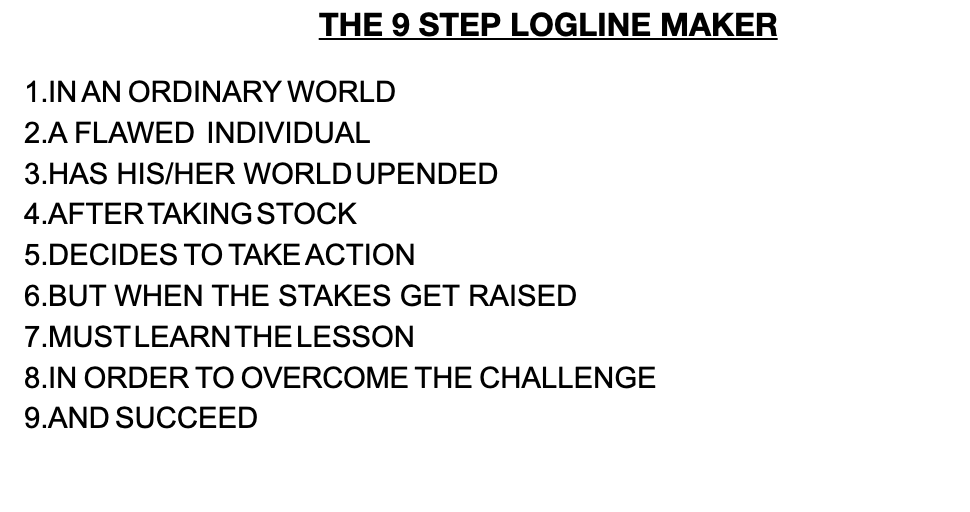
Oprah’s Golden Globes Speech – A great example of using Nested ABTs. Color coded in the ABT format.
‘Data-Driven’ Campaigns Are Killing the Democratic Party – Find your Christmas Tree problem.
Three Forms of the ABT – It’s recommended you read this article and get an understanding of the cABT (Conversational ABT).
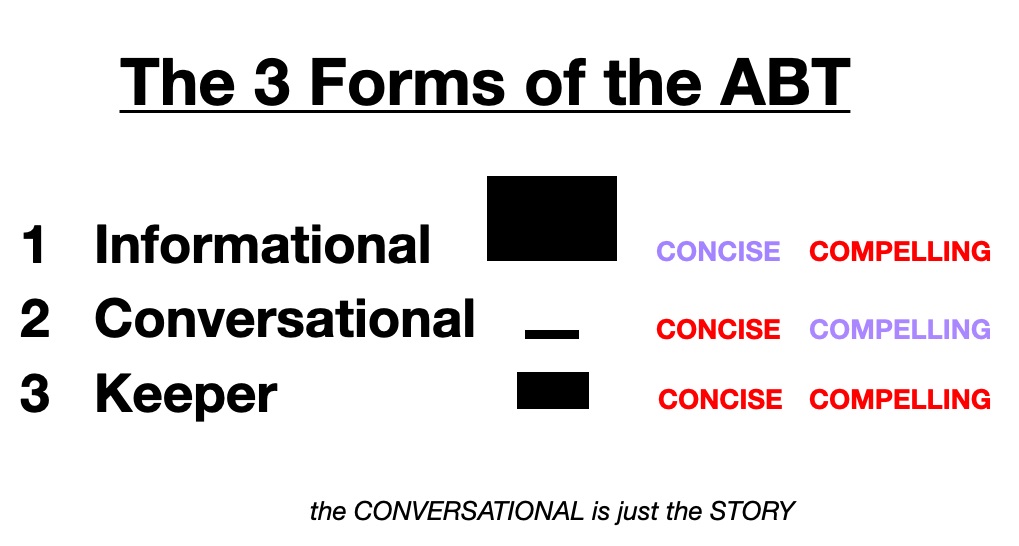
Optional Exercise #3: cABT – Starting from simplicity
Randy might ask you the cABT version of your ABT, so for this exercise you’ll prepare your cABT ahead of time.
The cABT should have all specifics stripped off of it. Use nothing but generic words. For example, if your ABT dealt with a new way to clean junk from the ocean that’s an improvement and the old system is outdated, the cABT would be “We had a thing we were using for a while, but it’s not working that great, so now we want to use a better thing.”
See? We can’t tell that you’re working on cleaning the environment. You could just as well be telling me that you’re implementing a new accounting system at your bank for all we know. That makes it a good cABT – the specifics are stripped out, leaving just the base narrative. And then from the base cABT, you can start adding specifics again when constructing your kABT.
Session 4 Resources – Archplot
Archplot vs Miniplot summary:
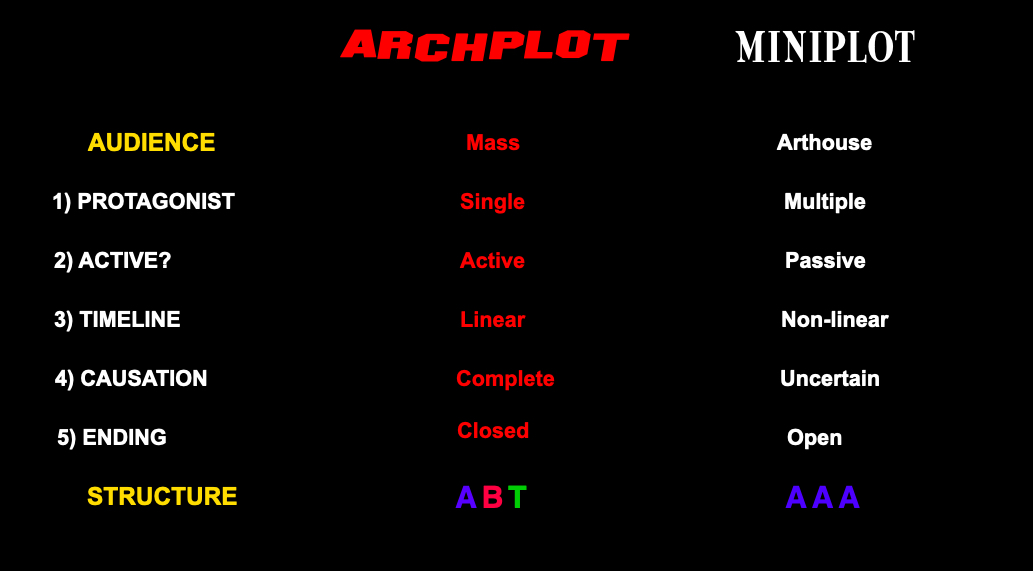
The “Fire Above and Below” episode of the ABT Time Podcast that Randy was referencing:
Optional Exercise #4: Using IF/THEN to draw on the power of the future.
Read about using the IF/THEN tool in “The Narrative Gym” (Chapter 5, print pages 41 thru 47, pdf pages 47 thru 53. Randy emailed all of you a pdf copy of The Narrative Gym. If you can’t find it, email mattmdavid@gmail.com for a replacement).
The IF/THEN tool isn’t applicable for all ABTs, but experiment and see if it is for yours. Try using a positive IF/THEN in the AND to help set the stakes to the Outer Circle of how great everything will be if it goes to plan. Or use a negative IF/THEN in the BUT to show the Outer Circle how bad things can be if everything goes astray. In either case, be as specific as you can to show the Outer Circle what is at stake if everything goes right in the AND or if everything goes wrong in the BUT.
Session 5 Resources – The Fool with Patty Limerick
Fools and Working Circles
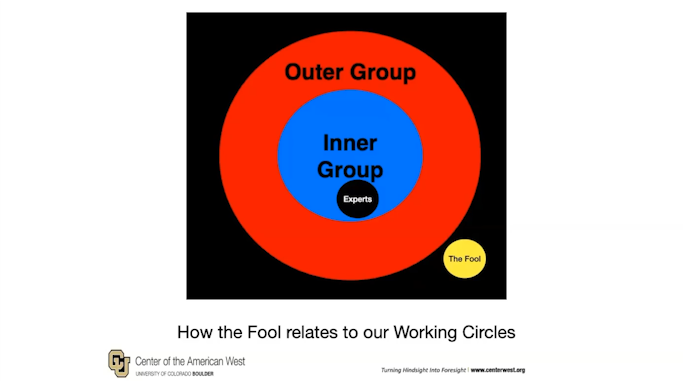
Not My First Rodeo – Patty Limerick’s Blog
Dancing With Professors: The Trouble With Academic Prose – A New York Times article written by Patty Limerick in 1993 about the problems academics have with communication. Still relevant today!
Optional Exercise #5: Past, Present, & Future
There’s a few different variations of the kABT. We’ll be looking at one of them here, the Past-Present-Future ABT.
The Past-Present-Future format isn’t applicable to all topics, but we can experiment and see if it is with yours. For your project, craft the AND in a way to tell the audience what was going on before in your project or your old method for addressing a problem. For the BUT, tell the audience the current problem with the old method of doing things. For the THEREFORE, let us know the solution that you’ll be attempting to implement in the future.
The cABT for a Past-Present-Future ABT might look like: “We were doing this one method for the longest time AND it worked well enough, BUT a new issue came up, THEREFORE now we have to fix it by doing a new thing.”
You could also attempt an IF/THEN in a Past-Present-Future ABT, for example: “We were doing this one method for the longest time AND it worked well enough, BUT a new issue came up and IF we don’t fix it THEN it’s going to get really bad, THEREFORE now we have to fix it by doing a new thing.”
Try filling in the details with your own project and make your own kABT using the Past-Present-Future ABT format.
Or fill in the details with facts about your life to make a Past-Present-Future ABT for introducing yourself at parties or networking events: “I was doing this one thing, BUT then a big issue came up, THEREFORE now I’m focusing on this other thing.”
And you can break out the Past-Present-Future ABT if you’re ever put on the spot by your employer with a question on where you’re at with a project at work. cABT: “Well boss, we got all this stuff done and it’s working great, but now we’ve got a new problem, so we’ll be doing a bunch of steps to fix it.” Fill in the details to that cABT on the fly and your boss should be up to speed on what you’re up to.
Session 6 Resources – Listening with Brian Palermo
Audience focused communication requires listening:
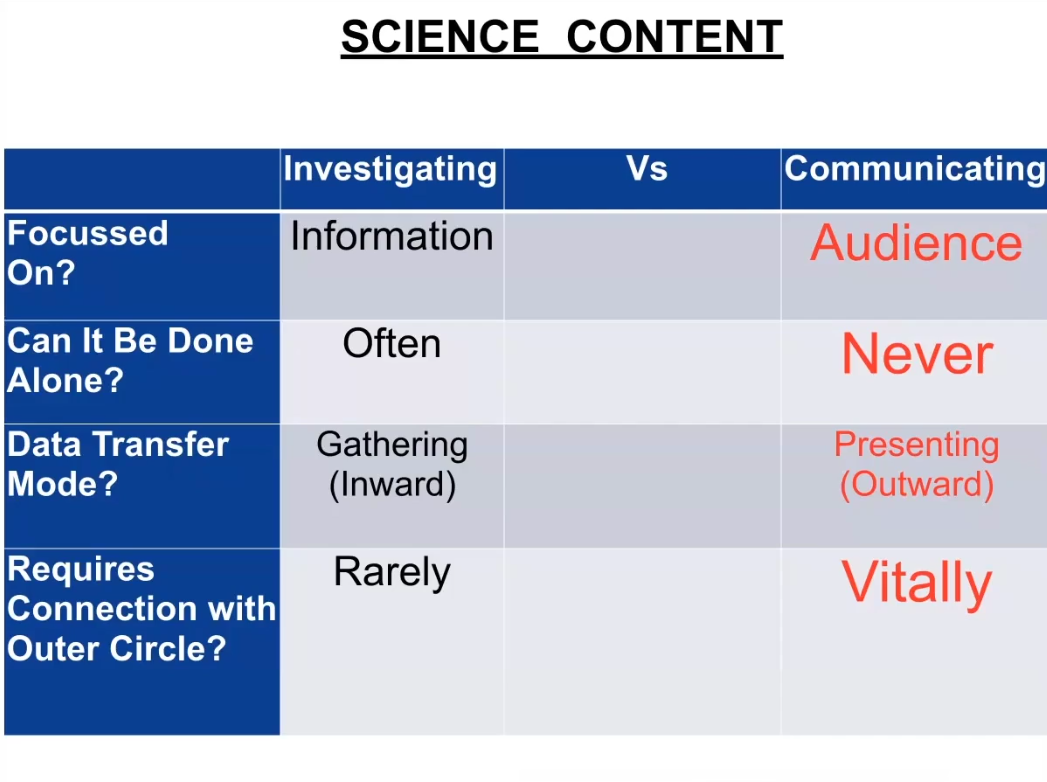
Brian Palermo’s Resources – Brian offers a number of resource videos on his website, some with interactive exercises built in. Topics include listening, utilizing emotional intelligence, and audience focused communication. He also offers online improv training to help improve listening and communication skills.
Optional Exercise #6: Expected Vs Observed – Leading us to the ideal world
Time to look at a different version of the kABT, the Expected Vs Observed ABT.
The Expected Vs Observed ABT isn’t applicable to all topics, but we can experiment and see if it is with yours. For your project, paint a perfect world in the AND in which everything goes right, what you would Expect from your “ideal world.” Unlike the Past-Present-Future ABT, this time you’re starting the AND out in the ideal, perfect future, not the past. A positive IF/THEN in the AND is often helpful here in really driving home what the stakes are if all goes according to plan.
Then for the BUT, tell us the problem that you’re Observing which is interfering with this perfect world you envisioned in the AND.
Finally, for the THEREFORE, tell us how you’ll lead us out of the problem of the BUT and back to the ideal world of the AND.
(This is often a great ABT for people who work on climate change projects. Climate change has been such an ongoing problem that it’s a part of our past now, so instead of looking at the climate change ridden past, you’re looking at the ideal future where you’re actively solving the problems of climate change in the AND).
A typical Expected Vs Observed cABT: “We’ve got this great project AND IF everything goes to plan THEN we’ll get all kinds of great benefits BUT right now it’s not working because of a problem THEREFORE we need to fix it by doing some stuff.”
Try filling in the details with your own project and make your own kABT using the Expected Vs Observed ABT format.
Session 7 Resources – Audience as Hero with Park Howell
Park Howell’s Business of Storytelling Podcast – Randy has been featured on a number of Park’s podcasts. Here’s the most recent episode with Randy.
Brand Bewitchery: How to Wield the Story Cycle System to Craft Spellbinding Stories for Your Brand – Park Howell’s book on using the ABT and the Hero’s Journey to help market your brand.
Optional Exercise #7: Audience as Hero
Time to look at a different version of the kABT, the Audience as Hero ABT.
The Audience as Hero ABT isn’t applicable to all topics, but we can experiment and see if it is with yours. In this ABT format, the audience is the hero of their own hero’s journey, and you (or your organization, process, project, product, etc.) act as the sage/mentor character that guides the audience through the special world to the solution.
Audience as Hero ABTs work best when you have a specific course of action that you want the audience to take, such as to buy a product, vote for a ballot measure, support a conservation movement, etc.
For the AND, start with the ordinary world of what you and the audience can agree on as important, properly setting the stakes for something the audience cares about. (Remember the class on Listening? This is where listening to and knowing your audience comes into play.)
For the BUT, tell us the problem that is putting the audience’s important thing at risk.
For the THEREFORE, you (or your organization, process, project, product, etc.) are introduced as the sage/mentor that guides the audience toward the solution to their problems. Remember, you are not the hero of this ABT, the audience is. You are just the guide.
A typical Audience as Hero cABT: “You know that this thing is important to you for some reasons AND IF you have this thing THEN stuff turns out great, BUT this thing is having a problem, THEREFORE we have the solution you can use to fix this problem.”
Try filling in the details with your own project and make your own kABT using the Audience as Hero ABT format.
Session 8 Resources – Genuflect to the Elders with Dianna Padilla
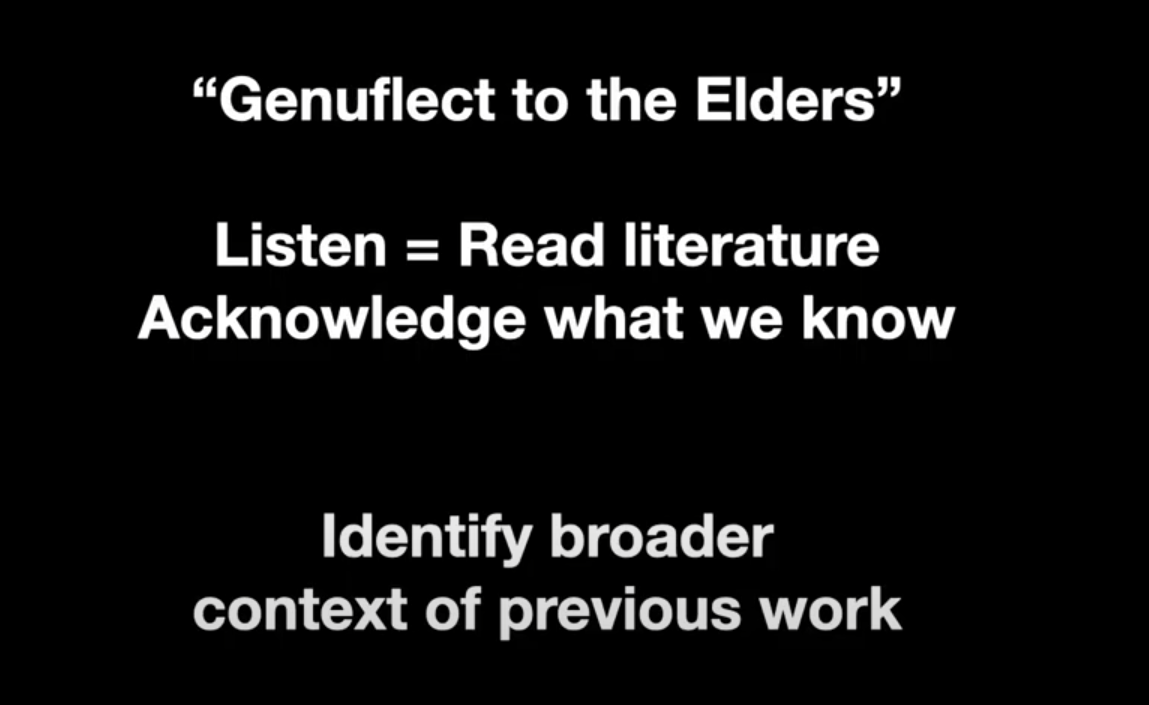
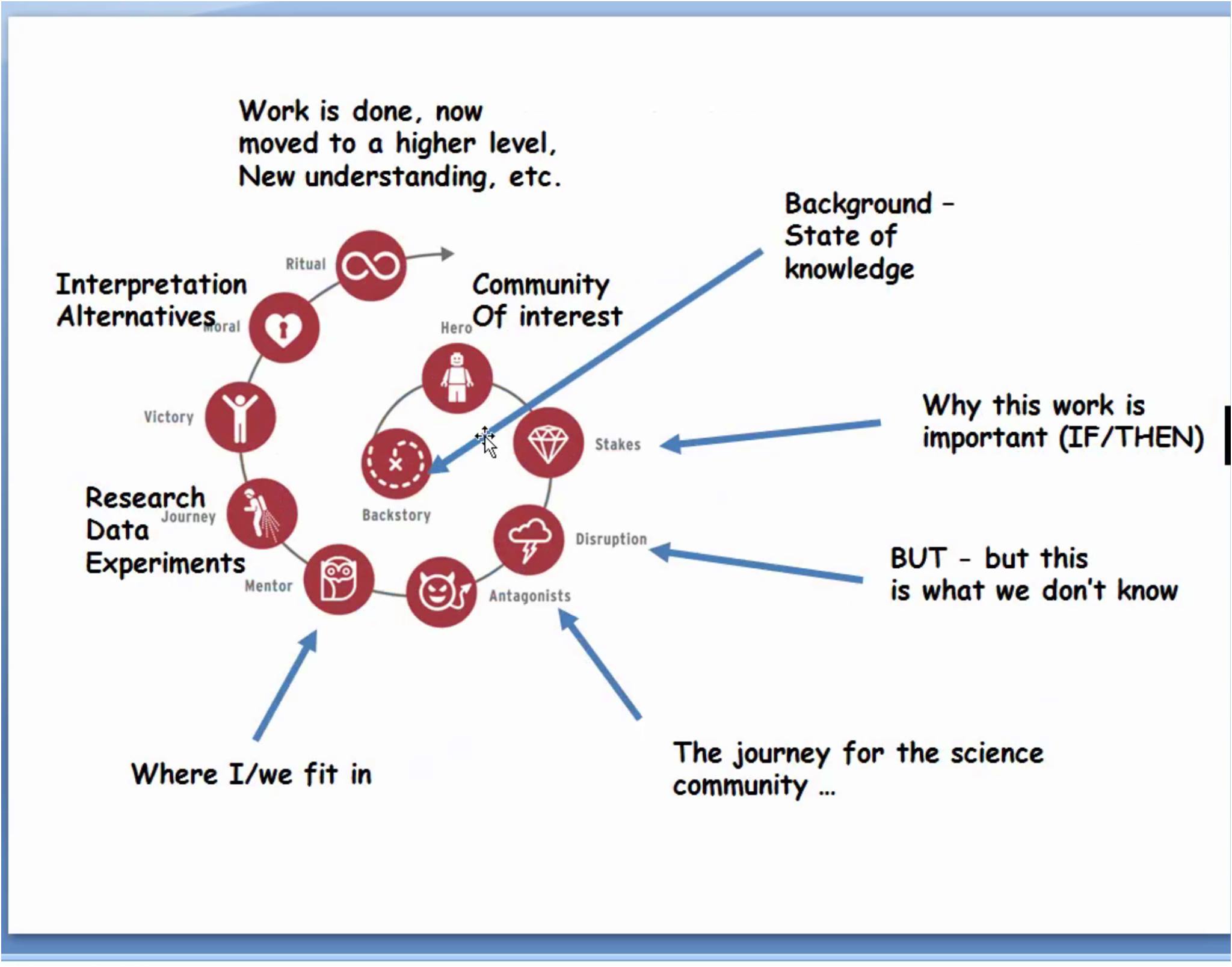
Advice on how women should pitch the “BUT” – A reply by Dianna to a former student’s question about the bias against women when they use the same strategies as men.
Are You Confused by Scientific Jargon? So Are Scientists – A New York Times article recommended by Dianna about how jargon clogs up scientific papers to the point that other scientists can’t understand them. Remember: your Inner Circle is always smaller than you think it is.
Optional Exercise #8: We Know This – The proof is in the past
Time for another form of the kABT, the We Know This ABT. Once again, a We Know This ABT isn’t right for every topic, but you can try and see if it is with yours.
A We Know This ABT (or as Randy likes to refer to it as, a Wenowdis ABT) is similar to a Past-Present-Future ABT, but this time instead of using the AND to look back at an old method that no longer works, we’re going to the past to look at a method We Know that works.
Set the AND at a place where you’ve seen past ideal circumstances that are similar to our current circumstances. We’re reaching back to the past for proof that we’re on the correct track, for evidence that this plan is the correct one.
The BUT typically involves what’s preventing you from using this great plan that’s always worked before.
The THEREFORE is your fix to get you back on track to your perfect tired-and-true plan.
cABT: “WE KNOW this process is important and IF we do it THEN we’ve seen great benefits BUT we can’t use it right now because of a problem THEREFORE we need to fix the problem by doing some things.”
Alternate cABT: “There’s a thing that’s important and WE KNOW IF we use this process on it THEN we’ve seen great benefits BUT we can’t use it right now because of a problem THEREFORE we need to fix the problem by doing some things.”
Fill in the details and see if you can make a We Know This ABT from your topic.
Session 9 Resources – Narrative is Leadership
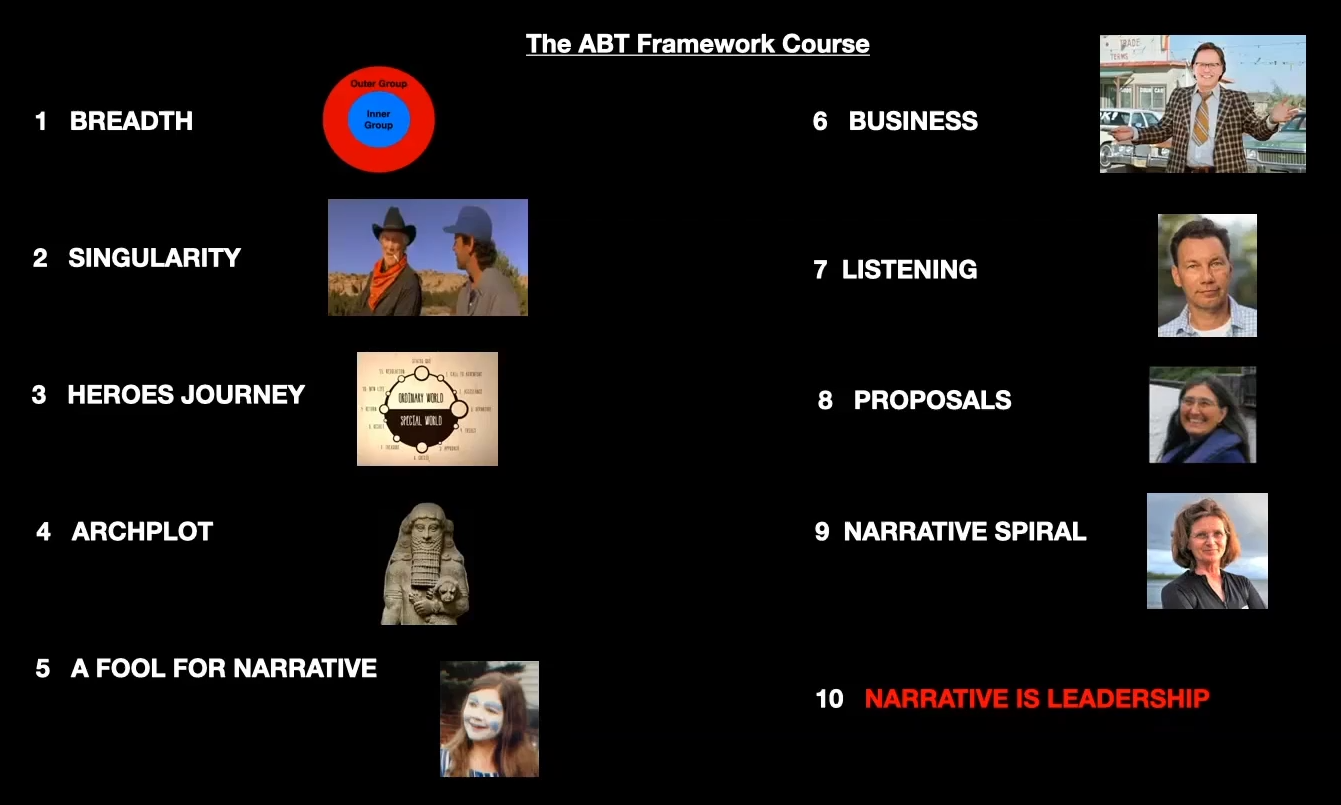
AND Frequency and Narrative Index score ratings:

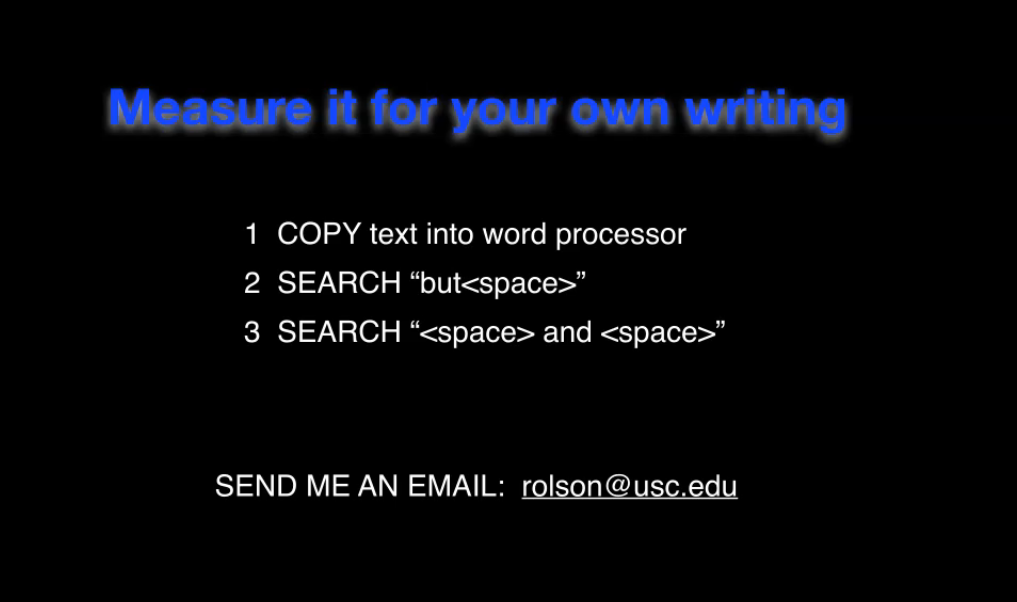
Randy’s interview with Andy Revkin:
Randy’s Recent Articles:
- Medpage Today: Covid Leadership: Trump Vs. Cuomo
- Scientific American: A New Tool for Humanizing Medicine
- Ensia: Two Decades Ago Climate Communications Missed a Huge Opportunity
Optional Exercise #9 Long Form ABTs – See how the pros do it
One of the most common questions we receive is “how can we use the ABT in real life?” Our participants wonder if it’s only used for the summary section, if it’s just a one and done thing.
Not at all.
For this exercise, you’ll go and examine how the pros do it – the journalists and their editors whose job it is to communicate with the widest range of audiences using language that’s meant to engage their readers and keep them reading.
First, pick a major news publication of your choice, a newspaper or magazine, such as the New York Times, The Atlantic, Time Magazine, The Economist, etc. Pick out one of their front page or featured articles that interests you. The front page and featured articles will be the ones that journalists and editors have given the most amount of scrutiny toward in writing and revising for a tight narrative.
Next, go through the article and find every BUT. (Using ctrl+F or cmd+f is helpful here if you’re computer savvy.) Notice how every BUT presents a new problem that furthers the narrative, driving the story forward. After the BUT sentence there are several sentences of green consequence material or blue agreement material that go toward setting up the next BUT.
Every major story follows this format.
If you’ve feeling especially proactive, copy the news story into a Word or Pages doc and color code what you think are the Blue, Red, and Green sections to see how the story flows throughout. Or if you don’t have the time, Randy did it for you in Oprah’s Golden Globes speech which was an ABT Masterpiece.
Professional journalists (and Oprah’s speechwriters) are masters at stringing together ABTs to talk about complicated problems in a way that’s easily digestible to the broadest audiences. From here on out, try to be more conscious of the narrative structure that journalists are using on you in these stories, pick up on their patterns, and try to use them in your own writing and presentations.
Session 10 Resources – Narrative Spiral with Nancy Knowlton
The Narrative Spiral:
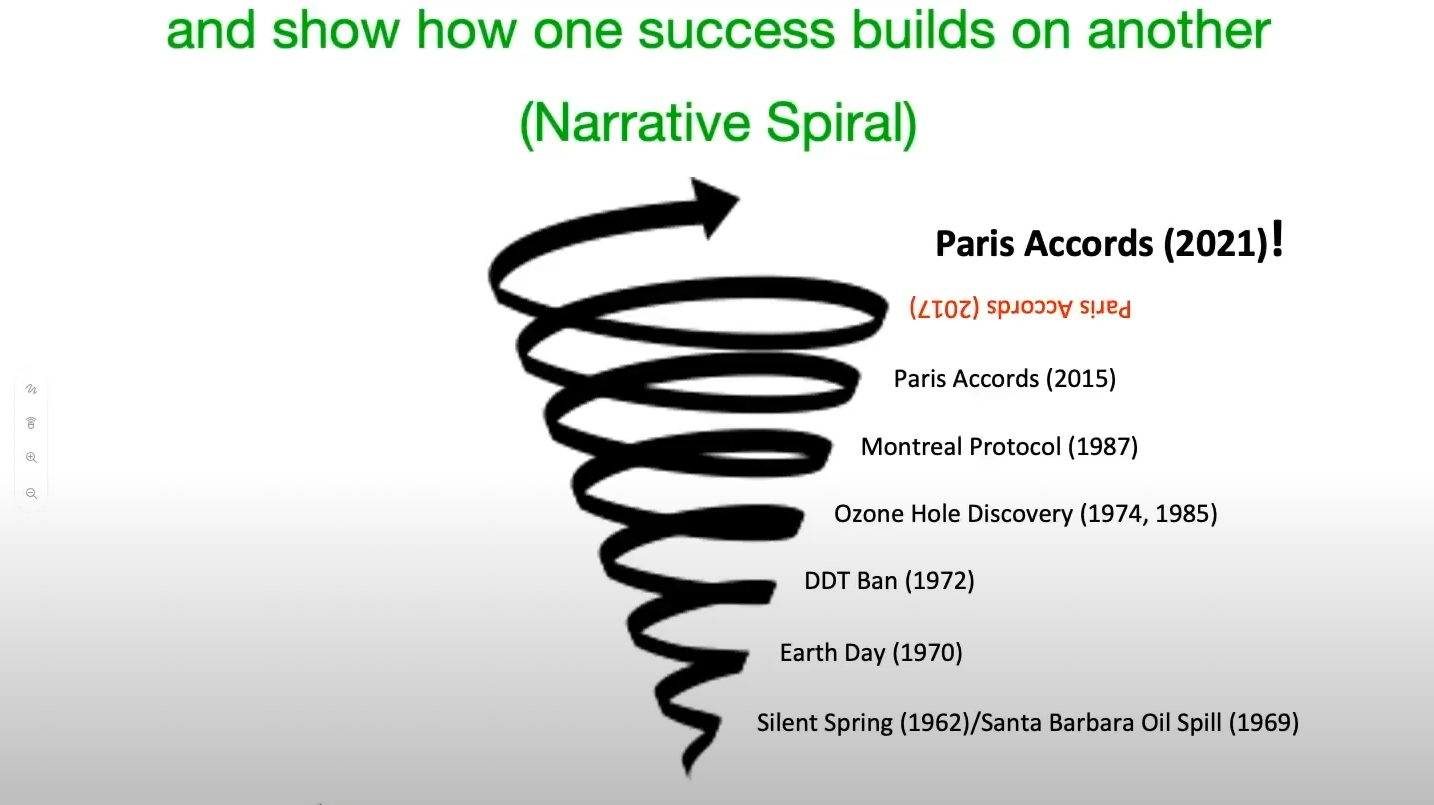
Individuals with greater science literacy and education have more polarized beliefs on controversial science topics – The paper Nancy referenced that shows how science literacy and political affiliation effect belief in controversial topics. Despite what scientists would like to believe, more information isn’t always the right answer.
UN climate reports are increasingly unreadable – This is what we’re fighting against.
Citizens of the Sea: Wondrous Creatures From the Census of Marine Life – Nancy Knowlton’s book.
Earth Optimism – A movement that Nancy is heavily involved in to help highlight the upward rise of the climate movement’s narrative spiral.
Katharine Hayhoe – The Evangelical Christian and Climate Scientist who emphasizes shared values when teaching about climate change.
The ABT Framework Google Group
We have an ABT Framework Google Group set up for all the current students and alumni of the Course. If you join, you’ll be able to create and submit new Working Circles for brand new ABTs for projects that you’re working on to get ABT feedback from others who have trained in this method. And you can participate in new Working Circles from future classes and alumni submissions to help hone your ABT skills.
To sign up for the ABT Framework Google Group, you can email Matthew (mattmdavid@gmail.com) a Google account email address (i.e. @gmail.com) to be able to visit the page directly. Or you can send him a non-Google address and still participate by receiving email updates from the Google Group whenever new Working Circles are posted.
Science Needs Story – Randy Olson’s Blog.
@ABTAgenda – Follow Randy on Twitter.
ABT Time Podcast – All things ABT, start to finish. In this weekly hour long post Randy will discuss observations, applications and implications of this powerful tool that is at the core of his narrative training program and effective communication of all forms. Livestreamed every Wednesday at 3:00 pm Pacific time on Youtube. Available the next day for audio download.
ABT Framework Course & Story Circles Grads – A private Facebook group just for graduates of the course where you can post about any ABT related topic you find around the ‘net. Once you request access, we’ll let you in.
Story Circles & ABT Training – An open-to-all Facebook Fan page.
The ABT Agenda Newsletter – We send out a newsletter a few times a year with new ABT related events, news, and course updates. If you sign up, we promise not to spam you with tons of junk!
“They Say / I Say” – A book on arguing in an ABT-like style.
Uri Hasson’s Paper on Neurocinematics – For a look at how narrative and non-narrative affects the brain. This paper was referenced in the AAAS video.
